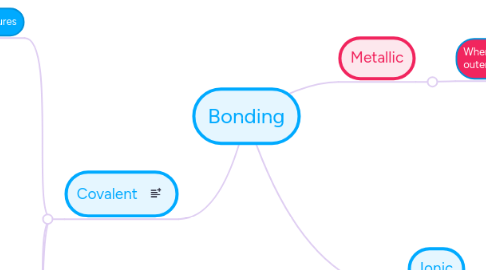
1. Covalent
1.1. Giant structures
1.1.1. Diamond
1.1.1.1. Large tetrahedral structure
1.1.1.1.1. Each C atom joined to 4 other by strong covalent bonds
1.1.1.2. Properties
1.1.1.2.1. Colourless transparent crystals; sparkle in light
1.1.1.2.2. Hardest natural substance
1.1.2. Joined by strong covalent bonds
1.1.2.1. High m.p, b.p
1.1.2.2. Usually hard and strong
1.1.2.3. All atoms in giant structures are uncharged, will not conduct electricity
1.1.3. Silica
1.1.3.1. Similar structure to diamond
1.1.3.2. main substance in rocks, pure silica called quartz
1.1.4. Graphite: special case
1.1.4.1. Common form of carbon found in sôt, charcoal, pencil leads
1.1.4.2. Each C atom connects with 3 other to form hexagonal layers
1.1.4.2.1. can slide over each other, so ions can move towards electrode, can conduct electricity
1.1.4.3. Properties
1.1.4.3.1. Dark grey, shiny solid
1.1.4.3.2. Soft layers can slide over each other, solid has slippery feel
1.2. When non-metals share electrons
1.2.1. Often liquids or gases at room temperature
1.2.1.1. Made of simple molecules joined together by covalent bonds
1.2.2. Low m.p. and b.p.
1.2.2.1. Intermolecular are weak; Not much energy needed to move molecules further apart
1.2.3. Soluble in organic solvents such as ethanol or methylbenzene (few are soluble in water)
1.2.3.1. Covalent molecular substances dissolve in covalent solvents
1.2.4. Do not conduct electricity
1.2.4.1. No ions present to carry the current
1.2.5. The more electrons shared, the stronger the bond
1.3. Simple structures
1.3.1. Usually small molecules only made up of a few atoms
1.3.2. Atoms in each molecule held together by strong covalent bonds
1.3.3. Each of molecules held together by we
2. Metallic
2.1. When packed together, metal atom loses outer electrons into 'sea' of free electrons
2.1.1. Atoms become positive ions
2.1.2. Free electrons are delocalized and form a kind of electrostatic glue holding the structure together
2.1.3. Can conduct electricity because mobile electrons can move through structure, carrying current
3. Ionic
3.1. When nonmetals and metals transfer electrons, creating ions
3.1.1. Crystalline solids at room temperature
3.1.1.1. Regular arrangement of ions in a lattice, ions with opposite charge are next to each other
3.1.2. High m.p. and b.p.
3.1.2.1. Ions are attracted to each other by strong electrostatic forces; larges amounts of nergy are neede to separate them
3.1.3. Often soluble in water, not usually soluble in organic solvents
3.1.3.1. Water is attracted to charged ions and therefore many ionic solids dissolve
3.1.4. Conduct electricity when molten or dissolved in water
3.1.4.1. In liquid or solution, ions are free to move about; ions can move towards electrodes when a voltage is applied
